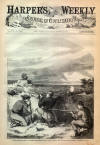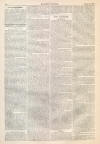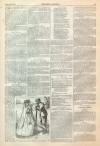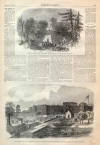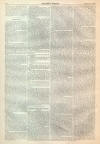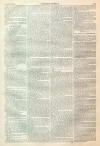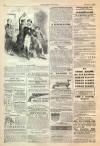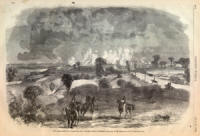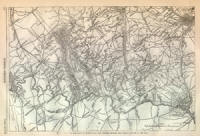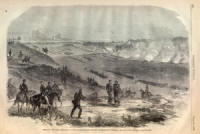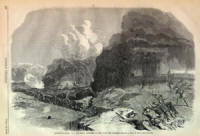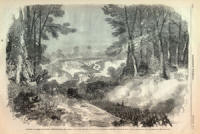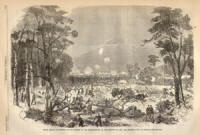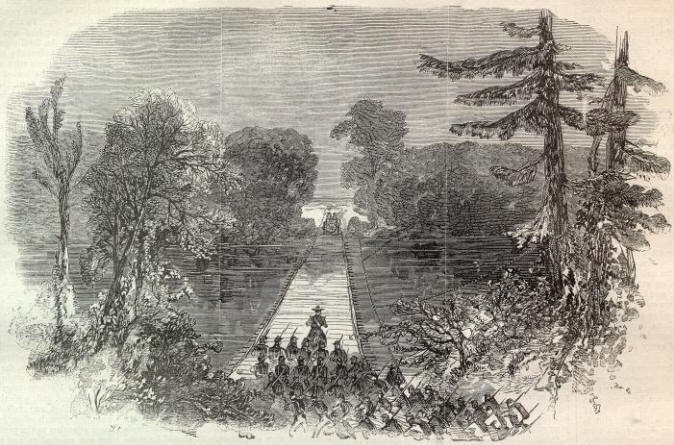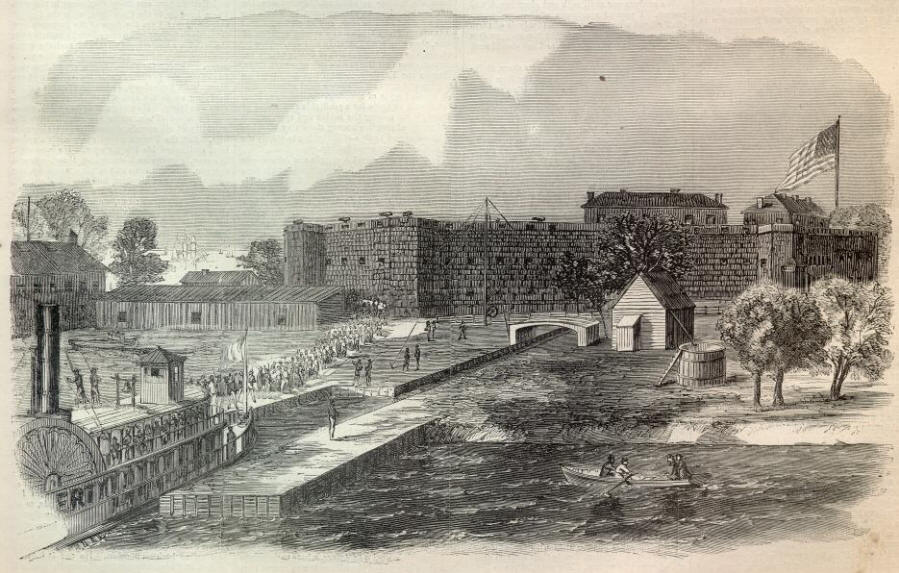|
This Site:
Civil War
Civil War Overview
Civil War 1861
Civil War 1862
Civil War 1863
Civil War 1864
Civil War 1865
Civil War Battles
Confederate Generals
Union Generals
Confederate History
Robert E. Lee
Civil War Medicine
Lincoln Assassination
Slavery
Site Search
Civil War Links
Civil War Art
Mexican War
Republic of Texas
Indians
Winslow Homer
Thomas Nast
Mathew Brady
Western Art
Civil War Gifts
Robert E. Lee Portrait
|
COTTON BRIDGE OVER THE BLACK RIVER.—[SKETCHED BY
MR. THEODORE R. DAVIS.]
THE
SIEGE OF
VICKSBURG.
WE continue in this number our
series of illustrations of General Grant's operations before Vicksburg, from
sketches by Mr. Theodore R. Davis. The pictures will be found on pages
401,
404,
and this page. Mr. Davis writes:
"THE APPROACHES AT
VICKSBURG.
"HEAD-QUARTERS OF MAJOR-GENERAL
M'PHERSON, May 28, 1863.
"The sketch is of an incident
coming under my observation while, a few days since, I was making my way, with
due regard for personal safety, through the trenches and rifle-pits to a point
from which a near view of the rebel works could be obtained.
"An officer of General
McPherson's staff, a fine shot, had taken his rifle, and was, with the
sharp-shooters, rendering it an impossibility to use a gun that had been used to
annoy our men at work in the trenches. A sharp-shooter from the
rebel works was crawling, as he
thought, unseen, to a point nearer our line. A hat placed invitingly was, in a
few moments, shot through by the ball from his rifle.
"The moment was the rebel's last:
he had exposed his head in shooting. And the sharp-shooting officer now wears an
airy hat. I am told by a deserter that seventeen men have been shot from a spot
called by them 'The Dead Hole.' Lieutenant-Colonel Strong, the sharp-shooter, is
the officer whose gallant escape from the rebels, some time since, near
Washington, was the subject of an illustration in this journal."
"THE CENTRE, UNDER COMMAND OF
MAJOR-
GENERAL M'PHERSON.
"HEAD-QUARTERS SEVENTEENTH ARMY
CORPS,
May 28, 1863.
"The view at this point conveys
perhaps a more comprehensive idea of the difficulties presented by the
exceedingly broken formation of the country than that at either the right or
left. Sketches of each position will follow this. Some of our troops have gained
by approach a point distant from the main work of the enemy but fifty yards.
"The battery of the late gallant
Captain De Solver was intrenched by him within one hundred yards of the enemy's
fortification. Many and heavy guns are within three hundred yards of the same
work.
"From our batteries and
sharp-shooters an effective fire is kept up to cover the construction of works
that will, without doubt, effect the ultimate fall of the strong-hold.
"A most gallant but unsuccessful
attempt was made upon the 21st inst. to carry these works by assault. Since that
time the sharp-shooters upon either side have been busy enough. The ping of a
shot is sure to follow the exposure of any portion of one's person. My pony and
sketch-book bear indubitable evidence that sketching in plain view of sharp-eyed
rebels must be rapid enough.
"One can hardly realize the fact
that our gallant men are, with the flag that the breeze ruffles, within a
stone's-throw of a work of immense strength. To dislodge our men the rebels
send, ever and anon, a shell, thrown by hand. Some of these grenades are seized
by our men as they come rolling and fizzing into the trench, and hurled back to
explode within the works of the senders.
"Confidence of the fall of
Vicksburg is the one feeling of our army."
THE COTTON BRIDGE OVER THE BLACK
RIVER. "HEAD-QUARTERS OF MAJOR-GENERAL McPHERSON,
SIEGE OF VICKSBURG, May 20, 1863.
"We had fought the battle of
Champion's Hill and captured the extensive line
of works at the railroad bridge over the Black River; but the bridge was
destroyed, and a deep and narrow stream was between us and Vicksburg. Our
engineers were soon, with their working parties, tearing down the 'gin-houses'
upon the adjacent plantations. With the timbers so procured raft-bridges were
soon in process of construction.
"One of the bridges built by
General McPherson's corps was so entirely novel that I send, with my sketch, a
detailed account of it. Two heavy beams thirty-five feet in length were joined
together by smaller beams ten feet in length, spiked two feet apart. This frame
now turned over, cotton bales were rolled into it in two rows, and secured by
stanchions at the side of each bale, and a beam crossing the top. These rafts so
fitted were now launched into the river, and, floated into place, were secured
by guy-ropes from the shore; stringers then placed, 'breaking joints,' the
entire length of the bridge, which was then 'decked over' with plank from the
demolished 'gin-houses.' Over this bridge the troops, artillery, and baggage
trains were safely passed.
"The ingenious constructor of
this bridge, Major Hickenlooper, Chief Engineer of General McPherson's
corps, has, during this brief but
brilliant campaign, earned for himself a most enviable reputation.
"This bridge is certainly the
most easily constructed, as it is the most secure, of any impromptu bridge
known. The buoyancy of a 500-pound bale of cotton is quite 400 pounds, and
serviceable for eight days."
ARMY
OF THE
POTOMAC.
WE illustrate on pages 408 and
409 a preliminary incident of the third passage of the Rappahannock by our
troops—namely, SHELLING THE REBELS OUT OF THEIR RIFLE-PITS. Mr. Waud, the author
of the sketches from which our pictures were taken, writes:
"The rifle-pits erected by the
enemy entirely commanded the crossing; therefore it was necessary to either
drive them out, or make it so dangerous to rise above the parapet that but few
would attempt it. The artillery massed on the river-bank did this effectually.
Lieutenant Wollaston's battery of
Napoleons (Battery D, Second Regulars) did magnificent practice; hardly a shot
missed the earth-work; its defenders, the Second Florida, were kept enveloped in
smoke and dust; and yet so great a protection is a little bank of earth, that
not a man was killed, though some were severely wounded. With a loss of some
forty killed and wounded engineers—including Captain Cross, a very fine officer,
and a graduate of West Point—the boats were carried down to the water and
launched; the Twenty-sixth New Jersey were ferried over, and carried the work at
the point of the bayonet, capturing some eighty prisoners.
"Some of these endeavored to get
away by running down the river, but a well-directed fire from Lieutenant
Wollaston's battery brought them to a stand-still, and they threw down their
arms.
"The First Massachusetts battery
was there, and also did good execution. We now hold the southern bank of the
river—Ayre's, Macartney's, and Wollaston's batteries in front, supported by the
Vermont brigade, one of the very finest bodies of soldiers in the United States.
I heard a pretty little anecdote of these men in connection with Wollaston's
artillery. While that officer was lying on the ground upon a paulin, among his
guns, a (Next Page)
THE ARRIVAL OF TWO THOUSAND
VICKSBURG PRISONERS AT FORT DELAWARE.—[SKETCHED
BY MR. D. AULD, FORTY-THIRD OHIO.]
|
